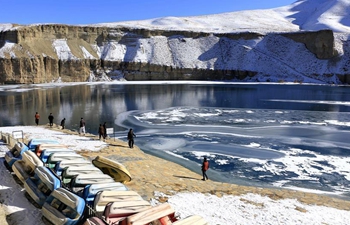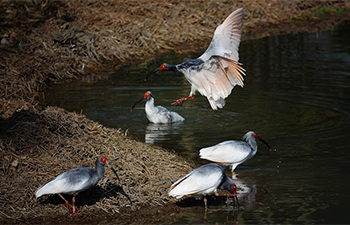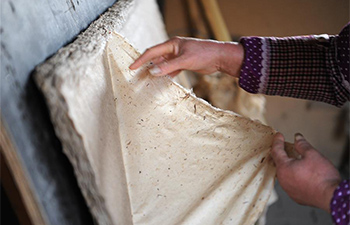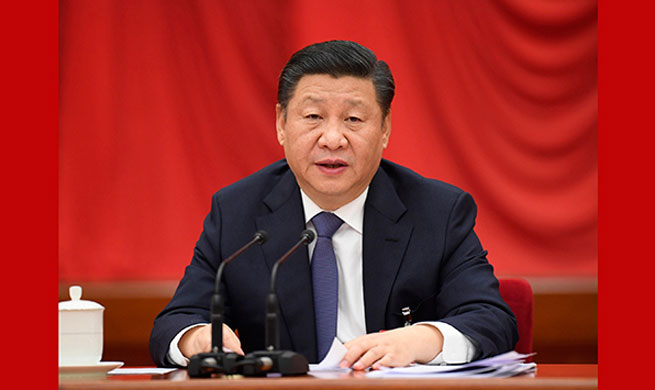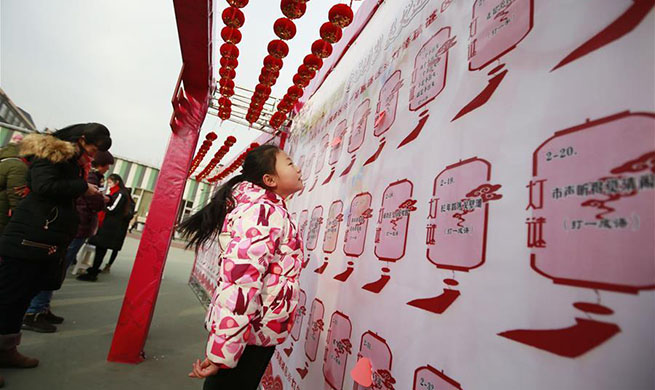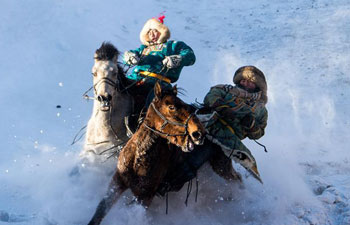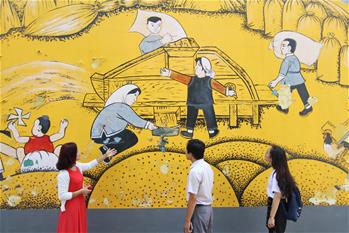by Burak Akinci
ANKARA, Jan. 20 (Xinhua) -- Wearing their old-fashioned Turkish nomadic war outfits with pride, students of a sports club in suburban Ankara tried hard to practice their archery skills as the traditional archery has become a current fashion in Turkey.
"This is the heritage of our ancestors, archery is essential in Turkish culture and we are trying to keep it alive today," said Arif Osman Gurdal, a 32-year-old veterinary physician who told Xinhua he was passionate about this ancient sport.
He is dressed from head to toe in the impressive uniform inspired by a medieval central Asian steppes roaming Turkish warrior of the Seljuk Empire, a Sunni Muslim dynasty that reigned over Anatolia and Persia and is considered as a precursor of the Ottoman Empire in the late 13th century.
"The outfit and the armor weighs about 30 kg, it is quite hard to practice archery in this costume and let's also not forget that these men were horseback warriors, so it becomes even more tricky to master the bow when you are riding on a fast-moving horse," explained Gurdal.
He is meticulously practicing in the Yildirim Okculuk Ihtisas archery school, pulling out his arrows one by one in a steady pace from his leather quiver to aim the target called "puta."
The sports center holds courses in both traditional and classic archery. It trains some 20 students in this ancient sport from both sexes and ages ranging from nine to 55, explained 35-year-old trainer Ismail Golluoglu. "There is no age limit to this sport. It can be practiced no matter you are a child or a middle-aged person, it is for everyone."
"People used to do flight archery centuries ago on these lands and here we are again doing it, it is fascinating," said Golluoglu, pointing out that the newly-emerging interest for Ottoman history also helps revive this ancient sport in the present day.
The excellence of the Turkish bows as opposed to bows used in western countries or in the east such as China, can be seen from historical record, he said.
"The record distance in the Ottoman period, in the 16th century, for an arrow shot was 845 meters," he noted, explaining that the European bows were less suited for flight archery as Turkish ones were smaller and could be shot at a speed of over 200 km per hour.
It is documented that each warrior was carrying about 100 arrows in the quiver, in the arrow case and even in the boots.
The modern day replicas are basically made of laminated and durable plastic covered with leather, but traditional recurved bows were added with fish bones, bull horns, cattle bones and tendons, and fine wood. The parts were attached by natural adhesives such as collagens extracted from fish or cattle.
The connection between the horse and the rider was exceptional. Horses were trained to understand whistle sound or even to lie next to their fallen or wounded riders, so they could climb back and become safer.
It has been half a decade since traditional archery events are organized by the Okcular Vakfi, an archers foundation located in an Istanbul district evocative of this age-old sport, known as Okmeydani, or the "place of the arrow," a neighborhood overlooking the Golden Horn where a lodge was built by Sultan Mehmet II the Conqueror, the most venerated of the Ottoman sovereigns who captured the Byzantine Christian Constantinople which became Muslim Istanbul 500 years ago.
Turkey hosts an annual traditional archery competition every May to commemorate the conquest of Constantinople in 1453. The competition was known as the Conquest Cup, an international event that welcomes archers from all over the Eurasian and Western world.
Okmeydani used to be an Ottoman archery range. According to historians, there were around 300 target stones by the end of the 19th century, but only 30 of them still remain, ignored largely by locals.
The stones are monuments erected by the Ottoman court to mark and commemorate where the sultan threw an arrow. It was also a tradition for the ruler to give out presents.
With the political rise of President Recep Tayyip Erdogan and his Justice and Development Party (AKP) who first came to power in 2002 and has now sweeping executive powers, conservative and religious Turks have reconnected with their Ottoman past. The mighty empire collapsed in the 1920s and was soon replaced by the secular modern Turkish Republic.
Every thing linked to the Ottoman era has regained public attention and the sport of ancient archery, which was deeply rooted in history and heritage, was no exception.
"We have somewhat forgotten our past but something is engraved in our consciousness and I think traditional archery is one of them, that is why there is such an interest for it today and we intend to pass it on to future generations," said Gurdal.
It was Erdogan, then Prime minister, who inaugurated in 2013 a modern archery range in Okmeydani, aiming to revive the old spirit of this neglected Istanbul neighborhood.
Historians depict vivid war scenes of the Ottoman area where agile Turkish soldiers, some of whom on horse back, were said capable of shooting 40 to 50 arrows within a few minutes, surprising the enemy who was fatally lured to follow the Turkish cavalry mimicking a retreat.
To mark the dedication accorded by the Turkish government to this martial art, Bilal Erdogan, the eldest son of the Turkish president, took over the reigns of the recently created Ethnosport Federation to which rallied several Turkic republics of Asia, organizing popular ancient games, such as horse back archery, horse back javelin throwing and oil wrestling.
Turkey is also actively looking for the inclusion of traditional archery into the prestigious UNESCO intangible cultural heritage list, in the light of the resurgence to this sport.




